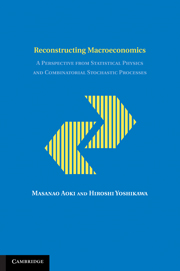 Reconstructing Macroeconomics
Reconstructing Macroeconomics Published online by Cambridge University Press: 08 August 2009
The new approach to macroeconomics and financial markets outlined in Chapter 1 requires mathematical methods and concepts that are quite different from those commonly used in economics. This chapter introduces them to the reader.
Phenomena we can analyze using the methods explained here share one or more of the following three features:
A finite but large number of micro units or agents interact.
Different “types” of agents are present.
New and unknown types of agents, products, or technologies may appear; that is, the number of types of agents, products, or technologies may not be fixed nor known in advance.
To analyze these phenomena, we must depart from the standard methods of model construction and analysis in mainstream economics. Specifically, in this book, we formulate models as continuous-time Markov chains, also known as jump Markov processes. This approach gives us new insight, and often yields more information on the behavior of the macroeconomy than the traditional approach can offer.
The standard approach in “micro-founded” macroeconomics formulates complicated intertemporal optimization problems facing the representative agent. By so doing, it ignores interactions among nonidentical agents. Also, it does not examine a class of problems in which several types of agents simultaneously attempt to solve similar but slightly different optimization problems with slightly different sets of constraints. When these sets of constraints are not consistent, no truly optimal solutions exist.
To save this book to your Kindle, first ensure [email protected] is added to your Approved Personal Document E-mail List under your Personal Document Settings on the Manage Your Content and Devices page of your Amazon account. Then enter the ‘name’ part of your Kindle email address below. Find out more about saving to your Kindle.
Note you can select to save to either the @free.kindle.com or @kindle.com variations. ‘@free.kindle.com’ emails are free but can only be saved to your device when it is connected to wi-fi. ‘@kindle.com’ emails can be delivered even when you are not connected to wi-fi, but note that service fees apply.
Find out more about the Kindle Personal Document Service.
To save content items to your account, please confirm that you agree to abide by our usage policies. If this is the first time you use this feature, you will be asked to authorise Cambridge Core to connect with your account. Find out more about saving content to Dropbox.
To save content items to your account, please confirm that you agree to abide by our usage policies. If this is the first time you use this feature, you will be asked to authorise Cambridge Core to connect with your account. Find out more about saving content to Google Drive.